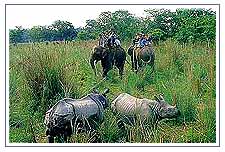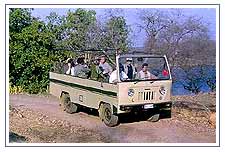The Royal
Bardia National Park is the largest and most undisturbed wild area of the
Terai region of the Nepal Himalayas. Similar to Chitwan park, but with a
drier climate and a more remote location, Bardia encompasses 1,000-sq-kms of
riverine grassland and sal forests.
The Terai or lowland hills and valleys of southern Nepal, nowhere over
1,000 feet in elevation, extend all along the Indian border. The Terai once
supported a healthy wildlife population in a habitat of 25-foot high
elephant grass and dense hardwood forests, but had very few people, due to
virulent malarial mosquitos.
Bardia was a royal hunting reserve of Nepal's Rana rulers from 1846 to
1950. In Nepal, wildlife lost whatever protection the royal hunting reserve
conveyed when the Rana rule ended in the 1950's. A well-meaning malaria
eradication program in the 1950's and 1960's opened the terai for
settlement, and transformed about 75% of the native Terai to agricultural
land. Wildlife populations declined with the combination of increased
settlement and widespread poaching. Bardia was declared a wildlife reserve
in 1976, first measuring 134 sq miles and expanded in 1985 to 374 sq miles.

Natural Beauty of Bardia National Park
Today's Royal Bardia National
Park is bordered to the south by the Babai River, to the north by the
Shiwalik or Churia Hills, to the west by the Girwa River (a tributary of the
Karnali), and to the east by a section of the East-West Highway which
bisects the park. The Terai is only in the southwest corner of the park.
Much of Bardia is on the southern slopes of the Shiwalik Range where the
hills rise to over 4,000 feet.
From the base of these hills, the park slopes gently over highly porous
ground for several miles to the rivers of the Gangetic plain. At Chisopani
Gorge, the swift-flowing Karnali River emerges from the Shiwalik Range onto
the broad plain and flows purposefully through the semi-tropical jungle.
Where the river braids out, small riverine forested islands form. Wildlife
frequent these oases - maybe you'll be as lucky as we once were to spot a
wild Elephant swimming trunk-deep across the river to reach the island.
Fuana In Bardia National Park
What makes a visit to Nepal's Royal
Bardia National Park particularly special is not just its large and intact
habitat area and its isolated location, but also the presence here of one of
the last known herds of wild Elephants in South Asia. The herd, numbering
less than two dozen, roams these remote jungles in western Nepal.
The largest of the herd is affectionately called "Thulo Hati",
which means "Big Elephant" in the Nepali language. Seeing these
wild Elephants greyish-white bulk rising above the morning mists and hearing
them trumpet across the jungle clearing is one of the most remarkable
wildlife experiences to be had on our planet.
Bardia also boasts the greatest number of deer species in Nepal. The six
deer species found in the park are: Chital or spotted Deer with its
ubiquitous white spots on a brown coat; Hog Deer; similar to but smaller
than Chital; Sambhar, the largest Deer on Indian subcontinent with a shaggy
coat and thick antlers; Swamp Deer; Barasingha; and reddish-colored Barking
Deer, the park's smallest Deer.
Other large mammals are: Gaur, the largest wild oxen in world; wild Boar,
an omnivorous black-coated creature with large tusks; the agile sloth Bear,
a shaggy black bear with a distinctive white "V" on its chest;
Blue Bull or Nilgai, the largest Antelope on the Indian subcontinent; and
Himalayan Tahr. Serow and Goral, two goat-Antelope members, are also found.
Small mammals include: Langur Monkey, Rhesus Macaque, Jackal, three species
of cats (jungle, leopard, and fishing); yellow-throated Marten; Mongoose;
and Indian Otter.
Two species of crocodiles swim in the Karnali, Girwa, and Babai Rivers -
the blunt-snouted Marsh Mugger and the fish-eating gharial with its long
thin snout. These creatures share the water with the fresh-water Gangetic
Dolphin. The Karnali also supports the great mahseer, which weigh up to 90
lbs, an angler's prize catch.
Birds are the park's most conspicuous fauna with over 300 resident and
migratory species. Avid bird-watchers will want to visit the park in
November or from February to April when migrants arrive, depart or pass
through.
To view the
wild Elephants, you ride on the backs of specially-trained elephants, each
guided by a driver. As you sit in a padded wooden platform on the Elephant's
back with your camera ready, your Mahout steers the Elephant through tall
grass. Mists rise off the nearby river, and you spot a mother Rhino leading
her baby down to the river for a drink. Monkeys chatter and birds call in
the nearby trees, signaling that an elusive Royal Bengal Tiger is stalking
Deer through the high grass. It's a very special experience - a unique
experience out at Royal Bardia - unlike any other wildlife setting in Nepal.
Air & Road:
To reach Bardia, take the daily air flight or public bus from Kathmandu to
napalgunj, from where it is a five hour drive to the park office at
Thakurdwara. This nature sanctuary is best visit from October to April.


 Natural Beauty of Bardia National Park
Natural Beauty of Bardia National Park